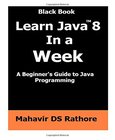Java 8 in Action
Lambdas, Streams and functional-style programming

Book Details:
| Publisher: | Manning Publications |
| Series: | Manning , In Action |
| Author: | Alan Mycroft |
| Edition: | 1 |
| ISBN-10: | 1617291994 |
| ISBN-13: | 9781617291999 |
| Pages: | 424 |
| Published: | Aug 28 2014 |
| Posted: | May 04 2015 |
| Language: | English |
| Book format: | |
| Book size: | 9.21 MB |
Book Description:
SummaryJava 8 in Action is a clearly written guide to the new features of Java 8. The book covers lambdas, streams, and functional-style programming. With Java 8's functional features you can now write more concise code in less time, and also automatically benefit from multicore architectures. It's time to dig in!Purchase of the print book includes a free eBook in PDF, Kindle, and ePub formats from Manning Publications.About the BookEvery new version of Java is important, but Java 8 is a game changer. Java 8 in Action is a clearly written guide to the new features of Java 8. It begins with a practical introduction to lambdas, using real-world Java code. Next, it covers the new Streams API and shows how you can use it to make collection-based code radically easier to understand and maintain. It also explains other major Java 8 features including default methods, Optional, CompletableFuture, and the new Date and Time API. This book is written for programmers familiar with Java and basic OO programming. What's InsideHow to use Java 8's powerful new featuresWriting effective multicore-ready applicationsRefactoring, testing, and debuggingAdopting functional-style programmingQuizzes and quick-check questionsAbout the AuthorsRaoul-Gabriel Urma is a software engineer, speaker, trainer, and PhD candidate at the University of Cambridge. Mario Fusco is an engineer at Red Hat and creator of the lambdaj library. Alan Mycroft is a professor at Cambridge and cofounder of the Raspberry Pi Foundation.Table of ContentsPART 1 FUNDAMENTALSJava 8: why should you care?Passing code with behavior parameterizationLambda expressionsPART 2 FUNCTIONAL-STYLE DATA PROCESSINGIntroducing streamsWorking with streamsCollecting data with streamsParallel data processing and performancePART 3 EFFECTIVE JAVA 8 PROGRAMMINGRefactoring, testing, and debuggingDefault methods Using Optional as a better alternative to null CompletableFuture: composable asynchronousprogrammingNew Date and Time APIPART 4 BEYOND JAVA 8Thinking functionallyFunctional programming techniquesBlending OOP and FP: comparing Java 8 and Scala Conclusions and where next for JavaAPPENDIXESMiscellaneous language updatesMiscellaneous library updatesPerforming multiple operations in parallelon a streamLambdas and JVM bytecode
Download Link:
Related Books:
Windows Phone 8 in Action
Summary Windows Phone 8 in Action is a comprehensive guide to developing apps for the WP8 platform. It covers the Windows Phone Runtime and .NET APIs used to work with a phone's sensors and hardware, including the accelerometer, camera, gyroscope, GPS, and microphone. You will learn to write code to dial the phone, write emails, send text messages, and recognize speech. The book also teaches you to build applications that use location and push notification. About this Book With 10 million (and climbing) active handsets, Windows Phone 8 has become a real alternative to Android and iOS. WP users are hungry for great apps, so it's time for you to start creating them! Windows Phone 8 in Action teaches you how to design, build, and sell WP8 apps. In it, y...
Learn Java 8 in a Week
A Beginner's Guide to Java Programming
Level: Absolute beginner in Java. This book is for programmers who would love to learn Java quickly and firmly with hands on approach. After completing this book you will have core understanding of the Java programming language and Java platform. The book offers comprehensive coverage of Java fundamentals explained in a simplified language supported by examples.The book is divided into 29 chapters where each major topic has it's own chapter and each chapter has multiple examples to support and provide clarity on the concept. The topics covered in this book are 1. What is Java? 2. JDK and JRE 3. Setting Path Variable 4. Complier and Interpreter 5. The First Program 6. The HelloWorld Program 7. Anatomy of HelloWorld Program 8. Multiple Main Methods 9. ...
Java Reflection in Action
Explaining the Java Reflection API and providing techniques for using it effectively, this guide describes the capabilities that allow a program to examine and modify itself at runtime. The java.lang.reflect package and its uses are covered, including a detailed discussion of Java's dynamic proxy facility. Less obvious reflective capabilities, such as call stack introspection and the Java class loader, are addressed. In recognition of the limitations of Java Reflection, the various ways to use Reflection to generate code and surpass these limitations are detailed. A discussion of performance analysis techniques and a look ahead at what is new in JDK 1.5 is included....
2007 - 2021 © eBooks-IT.org



